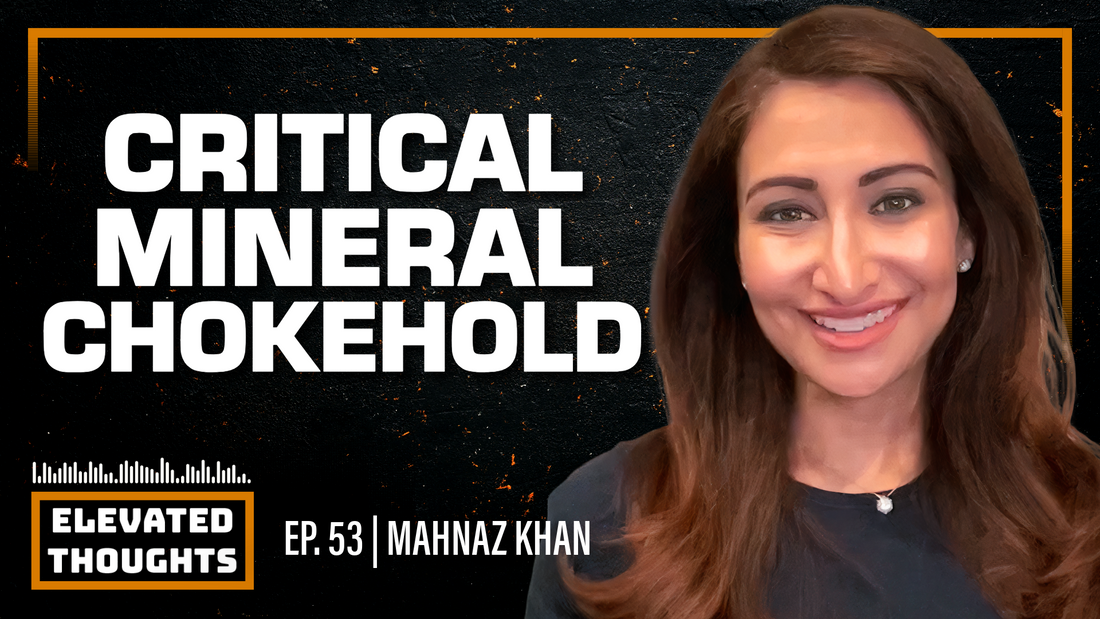
Episode 53: Are We Already Late on Critical Minerals? (Mahnaz Khan)
Share
We finally did the “what the hell are critical minerals” episode and it needed someone who’s lived inside the trade alphabet soup. Enter Mahnaz Khan—14 years across Commerce, the ITC, and USTR—now VP of Policy for Critical Supply Chains at Silverado (yes, co‑founded by our previous guest Dmitri Alperovitch). Translation: she’s seen how the wiring actually runs, not just the headlines. Her confession opener was perfect: she took the job thinking “diamonds and gold” and instead ended up seeing indium in your phone screen, lanthanum in your camera lens, rare earth magnets in your AirPods (her fourth pair), titanium and cobalt in the jet you fly, and a Chinese chokepoint behind most of it.
Simple frame: every “critical mineral” is its own ecosystem—50 different supply chains, not one monolith. China doesn’t just mine; it processed, subsidized, undercut, and bought its way into controlling the value‑add layers the rest of us outsourced while congratulating ourselves on “efficiency.” Rare earths are the case study: we led at Mountain Pass in the 80s, China subsidized and ignored environmental costs, we blinked, they grabbed the processing crown, and only now are we clawing pieces back as MP moves downstream into metals and magnets. It’s a rare win, but it took decades.
Mahnaz walked the escalation ladder: we block advanced semiconductor gear; Beijing replies with export controls on gallium, germanium, antimony, rare earth processing tech; we tighten again; they selectively target us (not everyone) and toss defense contractors on an unreliable list. That’s leverage practice, and they’re getting reps. Meanwhile we still treat “domestic mining” as a near‑term fix when reality is a 15–30 year permitting slog unless we streamline without trashing standards. So the only sane play is a two‑track timeline: long game (domestic extraction + processing + real recycling) and short game (ally and partner agreements that stitch together non‑Chinese refining capacity before Beijing vertically integrates further.
Her map of Chinese positioning is ugly: cobalt via majority mine stakes in the DRC, nickel saturation and dirty HPAL processing in Indonesia, lithium in the Southern Cone, bauxite in Jamaica and Guyana, niobium in Brazil. Pattern: buy the mine, build/own the rail, control the port, ship home, do the value add there, set global price floors that freeze prospective non‑Chinese projects before they clear financing. Oversupply isn’t an accident; it’s a strategic moat.
Tools we actually have (when we’re not busy shouting “tariffs” at everything): narrowly targeted export controls that preserve allied cohesion; forced‑labor import presumptions (think how UFLPA pressure reshaped apparel inputs) deployed early on minerals where alternative processing can scale in a five‑year window; bilateral critical mineral agreements with partners who have pieces of the puzzle; a credible “club” or pact that makes unilateral Chinese export bans trigger coordinated countermeasures instead of panic. But Congress already balked at a rushed Indonesia deal because Chinese nickel is embedded everywhere—so sequencing and transparency matter or the whole coalition play collapses.
Underrated point: recycling (“mineral recovery” in the current buzzword sheet) isn’t garnish—it’s the only medium‑term volume you can spin up faster than a greenfield mine. Yet we still ship mixed battery and e‑waste streams abroad without even clean data on what leaves. You can’t reduce dependence if you can’t measure the flow you’re hemorrhaging.
Ethics angle landed harder than usual: those viral cobalt mine clips aren’t abstract when 80% of major DRC assets link back to Chinese ownership and pricing power. Countries want U.S. partners precisely because we bring labs, workforce training, and environmental standards—basic capacity China often withholds to keep information asymmetry. They literally ask for help testing their own ore so they know what they’re sitting on. We’re leaving soft power on the table by showing up late or not at all.
Two illusions Mahnaz punctured: (1) “We have it under our feet, just dig”—having deposits ≠ having roads, power, processing economics, and a price floor China can’t crash; (2) “Decouple = flip a switch”—it’s a portfolio reweight across dozens of minerals, some we never produced domestically in any meaningful way. You unbundle risk by disaggregating each chain, not by chanting slogans.
Key takeaways: we’re in a tit‑for‑tat phase that previews a far harsher leverage contest once China closes its remaining tech gaps; domestic build is necessary but too slow alone; coalition discipline is squandered if we chase performative broad tariffs instead of synchronized, precise controls; recycling and recovery are the fastest neglected lever; and every month we delay clarifying which partnership model (bilaterals, club, defense‑linked pact) we’re pursuing is a free option for Beijing to deepen the moat.
If you want dopamine outrage, plenty of feeds will sell it. If you want to actually understand why lanthanum, gallium, and nickel policy might decide whether we still dictate the semiconductor stack five years from now—this is your spot. Subscribe, send this to the friend who thinks “just mine it here” is a Tuesday project, and meet us Wednesday at 4 PM EST. We’ll keep pulling on the threads that actually hold the system together.
